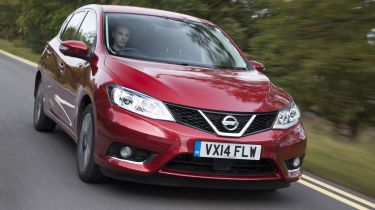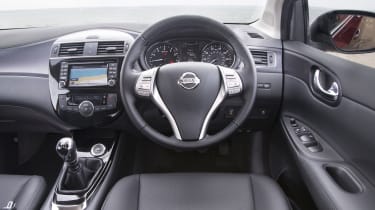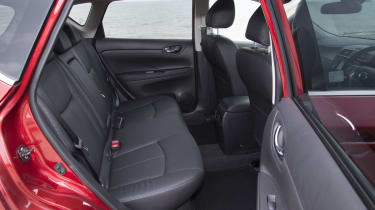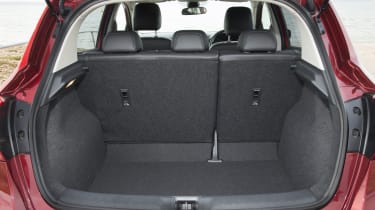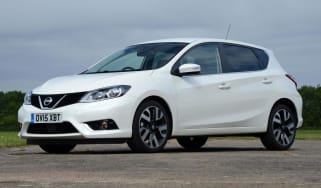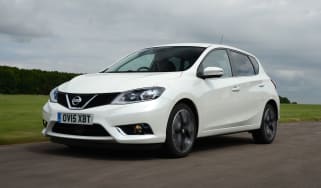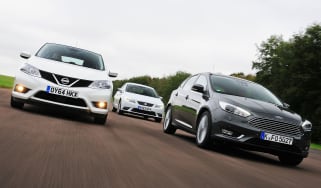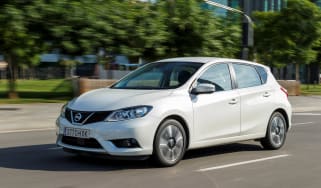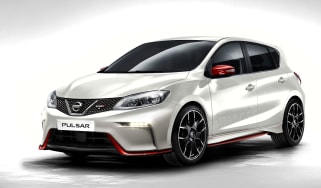Nissan Pulsar 2014-2018 review
The Nissan Pulsar fills a hatchback niche that was left vacant when Nissan first introduced the Qasqhai crossover

The sensible Nissan Pulsar is a practical hatchback that offers plenty of space for families, but it doesn't have much style or performance to go with it.
Its strong points include the spacious interior, which can shames larger cars from the class above, decent standard equipment levels, and a full-house of safety kit that delivers an impressive five-star safety rating. The downsized engines only offer adequate performance, but they are economical.
You won’t find much ‘sizzle’ in any part of the Pulsar driving experience, but if you’re only looking for practical, refined and comfortable A-to-B transport, the Pulsar is a sensible, but rather uninspiring choice.
The Nissan Pulsar is a mid-size family hatchback that's based on the same platform as the Nissan Qashqai crossover. That model replaced the dull Almera in 2006, and proved to be an instant hit for Nissan.
When the Qashqai launched, Nissan said it marked the end of hatchback production from the firm. However, while the Qashqai was a hit, Nissan decided in 2015 to reintroduce a hatchback using the same platform, engines and technology as the Qasqhai. However the Pulsar was never a strong seller in the UK, and the hatchback was withdrawn from sale again in 2018.
Used - available now

2021 Kia
Sportage
15,213 milesAutomaticPetrol1.6L
Cash £19,315
2024 BMW
iX3
21,755 milesAutomaticElectric
Cash £31,197
2024 Volkswagen
Golf R
19,953 milesAutomaticPetrol2.0L
Cash £30,976
2026 BMW
i4
20,499 milesAutomaticElectric
Cash £28,697Part of the reason for the Pulsar's failure was the sheer breadth of talent in the hatchback class made it an also-ran from the start. Attractive attributes such as its excellent interior space, cruising refinement and suite of driver aids grouped under the ‘Nissan Safety Shield’ umbrella couldn't help it. Competitive pricing meant it was a rival for models such as the SEAT Leon, Hyundai i30, Kia Ceed and Peugeot 308, although it was a step too far for the Nissan to compete with the likes of the Ford Focus, Mazda 3, Honda Civic and Volkswagen Golf.
The Pulsar was launched with two engines options in 2014. There was a 1.2 DIG-T 115 turbo petrol, or a 1.5 dCi 110 diesel. Only the 1.2 petrol is available with Nissan’s Xtronic CVT automatic gearbox, though.
In May 2015 the more powerful 1.6 DIG-T 190 turbo petrol joined the line-up, while the suspension was revised to add a sportier feel, including sharper steering and a stiffer chassis. The Pulsar DIG-T 190 is recognisable by minor styling upgrades inside and out, including unique 18-inch alloys. This is the performance flagship of the range, and remaind as such, because while a Pulsar Nismo hot hatchback was mooted, it never came to fruition.
The trim range for the Pulsar is the same as it is for the Qashqai. That means there's Visia, Acenta, n-tec and Tekna models. The only engine and trim combination you can’t have is a Visia model with the 1.6 DIG-T 190 petrol.
From Visia upwards, all models have a healthy standard spec, including a five-inch colour TFT display in front of the driver, six airbags, Bluetooth and iPod connectivity, cruise control, air conditioning, tyre pressure monitoring and a CD player.
Acenta trim adds a six-speaker stereo, automatic lights and wipers, dual zone AC, fog lights, heated mirrors and a leather steering wheel to the kit list.
N-tec trim highlights include privacy glass, LED headlamps, NissanConnect infotainment and a reversing camera, while Tekna trim is well equipped, with heated leather seats, plus the full Safety Shield package with Lane Departure Warning, Blind Spot Warning and a surround camera system.
The Pulsar name isn't a familiar one in the UK, but it has been used worldwide on models that were called the Cherry, Sunny and Almera in the UK. Unlike the Qashqai, which is built at Nissan’s plant in Sunderland, the Pulsar is assembled in Barcelona, Spain. Not only is its platform shared with the Qashqai, it also underpins the latest Renault Megane, Kadjar and Scenic models.
While the Pulsar was never a sales success for Nissan, it's now quite a promising used purchase. Depreciation has seen prices fall faster than they have for the Qashqai, and if you don't want the high riding SUV looks of that car, the Pulsar offers all the same kit and nearly as much space as its crossover cousin.
Engines, performance and drive
Nissan admits that when developing the Pulsar, it didn’t aim for the fun factor of the Mazda 3 or Ford Focus, Instead, it targeted the refinement of the VW Golf and Audi A3. In most respects, it has succeeded. Apart from a flutter of wind noise from the large door mirrors above 65mph, the Pulsar is very quiet at a cruise, especially with the 113bhp petrol engine instead of the slightly noisier 109bhp diesel.
Point the Nissan down a twisting back road, and you’ll discover strong grip and direct steering. There’s no feedback through the wheel, though, and the car suffers from some distinct body roll. Torque vectoring helps to resist understeer, while the progressive brakes and precise gearshift are easy to use.
Although the Pulsar is far from entertaining to drive, its refinement and space mean it deserves more credit among its talented rivals than the long-forgotten Almera ever mustered.
If taking it easy, wind and road noise are well suppressed, but while the combination of soft suspension and 16-inch wheels soaks up big potholes and bumps, the Pulsar feels unsettled on rough surfaces. Still, the driving position provides good visibility.
The faster 1.6-litre turbocharged model arrived in 2015, but even the extra power and chassis tweaks haven’t turned the Pulsar into a truly entertaining car. Instead, decent ride quality and light controls remain the order of the day here.
Engines
The engines are mostly well-mannered, though overly tall gearing forces them to labour harder than they otherwise might when accelerating, which blunts performance. No engine feels as sprightly as we’d hope, denting the car’s fun factor.
The entry-level 1.2-litre petrol engine makes the 0-60mph dash in a relatively leisurely 10.7 seconds and is flat-out at 118mph. The bigger 1.5-litre diesel shares the same top speed but takes almost a second longer to go from 0-60mph. It’s worth noting that if you choose the diesel for its good economy over long distances, you’ll save on fuel but lose a noticeable bit of refinement.
The 1.6-litre turbo petrol option brings the 0-62mph time down to a quite respectable 7.7 seconds, and raises top-speed to 135mph.
MPG, CO2 and Running Costs
The most economical Pulsar is the 1.5 dCi diesel, which has claimed economy of 78.5mpg and ducks under the 100g/km of CO2 mark at 94g/km. It’s only available with a manual gearbox, however.
For an automatic shifter, you’ll need the 1.2 DIG-T petrol and its Xtronic CVT. It added around £1,350 to the Pulsar’s list price, and hurts efficiency, dropping the 1.2-litre engine’s claimed figures from 56.5mpg and 115g/km to 55.4mpg and 119g/km. The 1.2-litre petrol is also cheaper to buy outright than the diesel.
The 1.6-litre DIG-T 190 option is predictably the least efficient, yet even this model returns a credible 49.5mpg and has CO2 emissions from 134g/km. Maximum claimed range on a full tank is 571 miles for the 1.2 petrol, 484 miles for the 1.6 petrol, and a whopping 793 miles for the diesel.
Insurance groups
Insurance for the Pulsar ranges from group 10 for the 1.2-litre petrol, but only if you choose a spec level that includes Forward Emergency Braking – that means Acenta, n-tec or Tekna. The basic Visia doesn’t have this feature, and the insurance is bumped up a couple of groups to 12 as a result. It’s the same story across the engine range.
The Tekna spec DIG-T 190 has the highest group rating, at 18. In fact, opting for Tekna spec with any of the engine options bumps the rating up by one group.
All in all the rates are competitive though, with the Pulsar undercutting the Volkswagen Golf by a couple of groups or more across the board.
Depreciation
The Pulsar offers a clear demonstration of the increased desirability of crossovers and SUVs when compared to hatchbacks. The five-door Pulsar is the hatchback equivalent of the Qashqai, as it uses the same platform, engines and technology as the SUV. However, depreciation is in the region of 34-40 per cent, which is some 8 per cent lower than it is for the Qashqai.
Depreciation relative to the Pulsar's hatchback rivals isn't so great, either. It's at the lower end of the market alongside the likes of the Peugeot 308 and Vauxhall Astra, and even behind cars like the Renault Megane and SEAT Leon.
The upside of this depreciation is that the Pulsar offers pretty good value for money on the second-hand market, and could be a decent purchase for anybody after a well equipped family car that doesn't desire the high-riding driving position or SUV looks of the Qashqai.
To get an accurate valuation on a specific model check out our free car valuation tool...
Interior, design and technology
Nissan’s clearly played it safe with the Pulsar’s looks, copying the ‘V-shaped grille’ and contoured bonnet from the Qashqai, although there are LED headlights available to give some visual interest.
Despite the ‘boomerang’ tail-lights, roof spoiler and contoured surfacing down the car’s flanks, the Pulsar appears boxy and rather awkward from some angles. Part of this is due to the 1.2 petrol and 1.5 diesel Pulsar only being available with 16-inch or 17-inch wheels – the larger 18-inch alloys on the 1.6-litre DIG-T 190 certainly help to balance the looks. On the other hand, big wheels jeopardise the commendable ride quality, so it’s a sensible compromise on Nissan’s behalf.
Lessons learned from the Qashqai have been incorporated inside, albeit with patchy results. The ‘floating’ centre stack is distinctive, and the steering wheel is taken straight from the Qashqai, but the wood grain-effect finish on the dash panel looks a bit tacky, and the interior light switch located above you looks straight out of the eighties.
The plastics aren’t up to the standard of those found in the Ford Focus or SEAT Leon, although the thoughtfully laid-out switchgear works with slick precision. The cabin is solidly screwed together, too, and well up to the rough and tumble of family life.
There’s plenty of standard kit, including Bluetooth and a USB connection. You also benefit from climate and cruise control, plus keyless entry. Further highlights include the Qashqai-style colour TFT display located between the speedo and rev counter, and gloss-black centre console finish.
Sat-nav, stereo and infotainment
You have to choose the n-tec or Tekna specification if you want sat-nav on a Pulsar, but you shouldn’t be disappointed by the NissanConnect infotainment system, which has smartphone integration built-in.
It works with iPhone, Android and Blackberry operating systems (although it's not Apple CarPlay or Android Auto compatible) and allows you to run various smartphone apps through the central touchscreen display on the dash. So if you’re a social media addict you can keep up to date on the move – or access more practical applications like Google or TripAdvisor.
Supplementing the central touchscreen is a five-inch TFT display between the dashboard dials that shows turn-by-turn info in sat-nav equipped cars, as well as other useful stuff like audio track details and Safety Shield status.
The standard audio system has a CD player and four speakers, but upgrading to Acenta spec or above gives you a six speakers.
Practicality, comfort and boot space
It’s a little boxy and not that pretty to look at, but the Nissan Pulsar has a genuinely Tardis-like interior which families will consider a great trade off. Shoulder room, headroom and legroom are all excellent for this class of car, and in some cases better than models in the class above.
It feels roomy too, with loads of space, big door openings, and a decent boot, which expands massively with the split-folding seats stowed. If space is your priority in a family hatch, look no further.
While boot space is good, storage elsewhere in the cabin is only average: unlike the Qashqai, the Pulsar doesn’t get an electric parking brake to free up space in the centre console. There is a decent glovebox however, and reasonably-sized door bins.
Dimensions and size
The Pulsar looks like a fairly ordinary family hatch, but in terms of interior space, it’s actually a rival for cars like the Ford Mondeo and VW Passat.
Inside, the Pulsar’s boxy body and class-best 2,700mm wheelbase pay dividends.
With 692mm of legroom, the Pulsar claims to have the most generous rear seat accommodation of any C-segment hatchback, and even enough room to embarrass certain D-segment cars. Passengers crammed into smaller family hatch alternatives will look on with envy.
Leg room, head room & passenger space
Occupants in the back have plenty of head and legroom, while the absence of a transmission tunnel means even passengers sitting in the middle of the rear bench get plenty of space for their feet.
It feels airy and spacious too, with plenty of natural light to brighten the grey cabin ambience. Wide-opening doors help, and the car feels wide enough to seat three adults across the rear seat for short trips. There’s a full complement of ISOFIX fastening points, as you would expect.
Boot space
Open the tailgate and you’ll find a generously proportioned 385-litre boot, which can be extended to 1,395 litres with the 60:40 rear bench folded flat. However, the load bay is scuppered slightly by a high lip, which can get in the way when you’re lifting luggage.
It’s helped by the fact that the car sits quite low to the ground, but nevertheless Qashqai-style false boot floorboards that create a hidden storage area wouldn’t go amiss. Compared to its rivals, the Pulsar offers a little more boot space than a VW Golf.
If you want to use your Pulsar to pull a trailer, don’t opt for the auto gearbox as it limits the towing capacity to a rather unimpressive 500kg. The manual gearbox cars can pull 1,200kg, although we’re not convinced the experience would be much fun.
Reliability and Safety
The Pulsar shares many of its mechanical components and electrical systems with the second generation Qashqai, which has performed reasonably well in our Driver Power survey.
Yet while the crossover has scored strongly for comfort and in-car technology, its patchy build quality has come in for some criticism. Just as disappointing was the performance of Nissan’s franchise network, which finished 29th out of 31 in our dealer survey.
While there are question marks over the Pulsar’s durability, there are no such worries about its safety credentials. All variants get a full complement of six airbags, stability control and a programmable speed limiter as standard.
Further peace of mind comes with Nissan’s award-winning Safety Shield technology, which includes a standard-fit low-speed collision avoidance system called Forward Emergency Braking on Acenta models and above.
Go for the n-tec and you’ll benefit from all-LED headlamps and a reversing camera, while the range-topping Tekna gets the added benefits of lane departure warning, blind spot monitoring and a 360-degree surround view camera set-up.
The Pulsar also scored a top five-star rating in the Euro NCAP crash tests in 2014, and was praised in particular for offering the same high level of protection to occupants of disparate shapes and sizes. This included NCAP’s 18-month old toddler-sized crash test dummy - which should offer reassurance to parents.
Warranty
All Nissans come with a three-year/60,000 mile warranty, which is about average for this class. If you want more cover, it’s worth remembering that the Hyundai i30 comes with a five-year warranty and the Kia Ceed has a seven-year warranty.
Servicing
Nissan’s fixed-price Service Care offer applies to the Pulsar, with minor services costing from around £150 on petrol models and £160 on diesel cars.
Major services are around £220 and £250, and Pulsar service intervals come every 12,500 miles for petrol models and every 18,000 miles for diesels.
